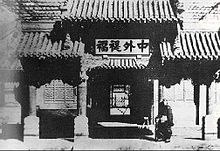Self-Strengthening Movement
The Self-Strengthening Movement (Chinese 自強運動 / 自强运动, Pinyin zìqiáng yùndòng also Westernization Movement, Chinese 洋務運動 / 洋务运动, Pinyin yángwù yùndòng) was an effort by the Qing government between the Second Opium War and the Sino-Japanese War to remedy China's weaknesses and prevent foreign domination by learning from abroad. The results of this movement could not prevent foreign powers from expanding their interests in China. It did, however, set in motion a cultural opening to the world whose effects were profound and lasting. The most important leaders of the Self-Strengthening Movement were Prince Gong, Li Hongzhang, Zuo Zongtang, and Shen Baozhen.
In 1846, Wei Yuan was the first to demand, in an analysis of the lost First Opium War, that China strengthen itself and acquire the technical means of the barbarians in order to dominate the barbarians and make China rich and powerful. During the Taiping Rebellion, the imperial troops suffered defeats due to the better armament of the insurgents with foreign war equipment. From 1854, high provincial officials such as Zeng Guofan, Hu Lingyi, Li Hongzhang, Peng Yulin, and Zuo Zongtang also equipped their armies with foreign weapons. After initial reluctance, the imperial court, led by Prince Gong, implemented a program aimed at technical modernization beginning in January 1861. This program included the creation of an Office of Foreign Affairs (Zongli Yamen, established on January 20, 1861) and the training of soldiers along European lines. Arsenals and arms factories were established in all provincial capitals, each employing 1000 to 2000 workers and headed by an imperial official. Three foreign language schools were established, namely in Peking (Tongwen Guan, 1862), Shanghai (1863) and Guangzhou (1864). Their most important task was to translate scientific works from foreign countries into Chinese. In 1872, the first Chinese students went to study in the United States. Parallel to the technical modernization, the first joint-stock companies with Chinese capital were also established. Companies such as China Merchants' Steam Navigation Company, several mines, textile factories and telegraph operators were established. In today's Wuhan, an iron-processing industry with 7,000 workers was established under Zhang Zhidong, and the first railway lines were built.
Proposals to make scientific knowledge part of the civil service examinations, on the other hand, were rejected by the imperial court. They wanted Confucianist values and traditional patterns of administration to continue to dominate the state system. This attitude of the Qing government subsequently hindered the self-strengthening projects time and again. A press also emerged in which officials or diplomats such as Feng Guifen, Guo Songdao, Xue Fucheng Huang Zunxian, Zheng Guanying, and Wang Tao often had their say. They explained that self-strengthening required not only the adoption of technology, but also the adoption of foreign scientific and political culture.
After the Japanese landing on Taiwan, defense policy became even more central. Xinjiang also had to be defended against a threatened invasion by Russia and the Dungan uprisings. Efforts to build up its own fleet were successful to the extent that the material backlog could be made up. However, the defeat in the Sino-French War between 1883 and 1885 showed that the striking power of the Chinese armed forces suffered from serious organizational deficiencies. Similarly, the defeat in the war against the erstwhile tribute payer Japan in 1894/1895 was caused less by material than by organizational inferiority. This defeat also spelled the end of the self-strengthening movement. China, however, was set on the road to participation in the world market, to modern capitalism, and to cultural opening. These trends could no longer be reversed.

The Zongli Yamen, founded within the framework of the Self-Strengthening Movement.
Search within the encyclopedia